Books
Books
published in 2022
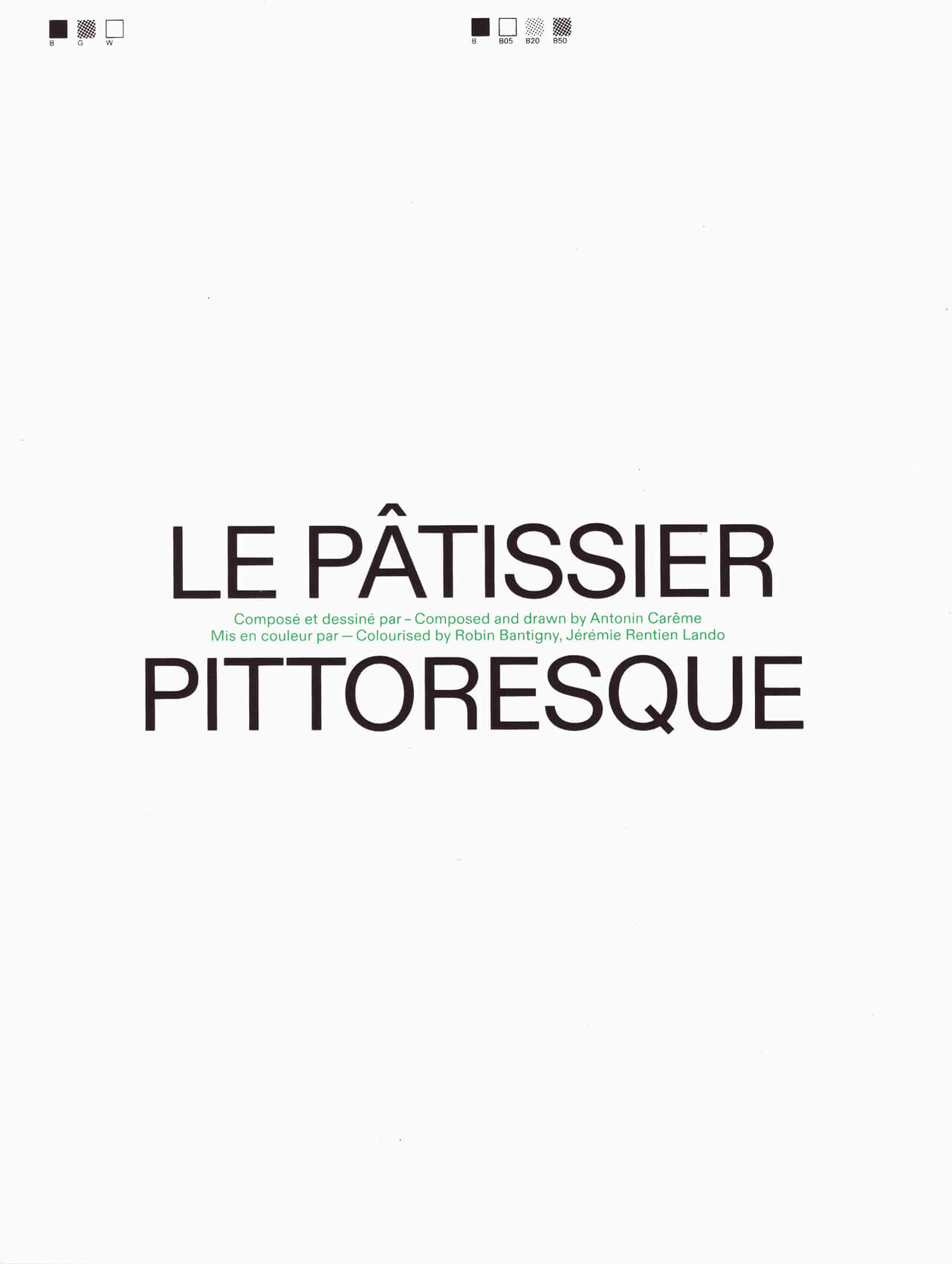
Le Pâtissier Pittoresque
This book is a colourised version of the 1828 “Pâtissier Pittoresque”. First published by french pastry chef Antonin Carême, it gathers more than a hundred sugar sculptures, all served on the buffet table of Emperor Napoleon I and king Louis XVIII.
Known in the cooking world for their elegant sobriety, the blueprints of these sculptures were, as of today, always published in black and white. Yet, the author refers to more than thirty of them in his introduction, instructing how the sugar paste and biscuit should be coloured to create the desired effect. Thinking himself more as an artist than as an artisan, this new colourised version is a testament to Carême’s effervescent creativity.
Colourised by Robin Bantigny and Jérémie Rentien Lando.
Co-published with Jan Van Eyck Academie

RUSTIQUE
“RUSTIQUE” is an artist book created by Nicola Godman. This book is sprung out of a residency in September 2021 at Hôtel Chevillon, a former Scandinavian artist colony in Grez-sur-Loing, France. Barbizon, the village where the painter Jean-François Millet (1814–1875) lived and died, is located 20 km away from there. The book interweaves the life and work of Millet with Godman’s photographs, drawings and personal anecdotes.
“RUSTIQUE” wishes to put forward the artistic gaze towards rural life by artists who themselves are born peasants. Nicola Godman (b. 1989, Rute) is an artist working with photography, video, books and stories, currently based in Stockholm, Sweden. Having grown up on an organic dairy farm, she is researching depictions of rural life in art history and contemporary culture.
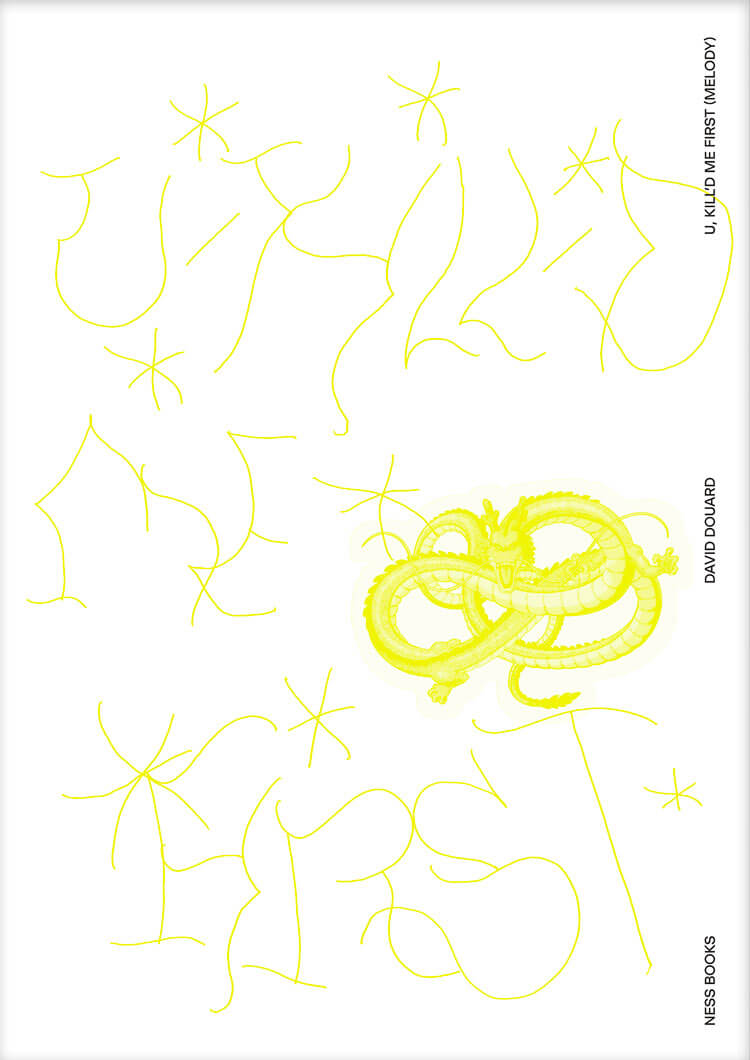
U, kill’d me First (Melody)
This publication constitutes a continuation of “Melody”, the installation created by David Douard for Sculpture Garden (2022 edition), acquired by the city of Geneva, and which was subsequently vandalized. This last point is at the heart of the book, which presents a graphic section bringing together reproductions of preparatory works for the piece, plates of images of the work in situ, and a discussion between the artist and the curator Devrim Bayar dealing with the status of this work during and after degradation.
Texts by Devrim Bayar and David Douard (in collaboration with Justine Dorion)

Verlag der Buchhandlung Walther König
Every Day is A New Day: Calendar 2023
Dutch graphic designer Karel Martens (born 1939) has been an influential figure in the visual culture of the Netherlands for many decades. Alongside his commissioned projects, Martens has maintained a commitment to this personal and iterative way of printing, which shows how creative practice often spans perceived disciplinary boundaries.
For each day of this elegant 2023 calendar, Martens has created a unique abstracted form to serve as a number—originally constructed using his signature method of printing letterpress monoprints from found metal forms, which are then digitized to comprise 365 compositions in total. The piece’s reference to the daily practice of art expresses Martens’ own approach as a designer and educator: “every day is a new day.”
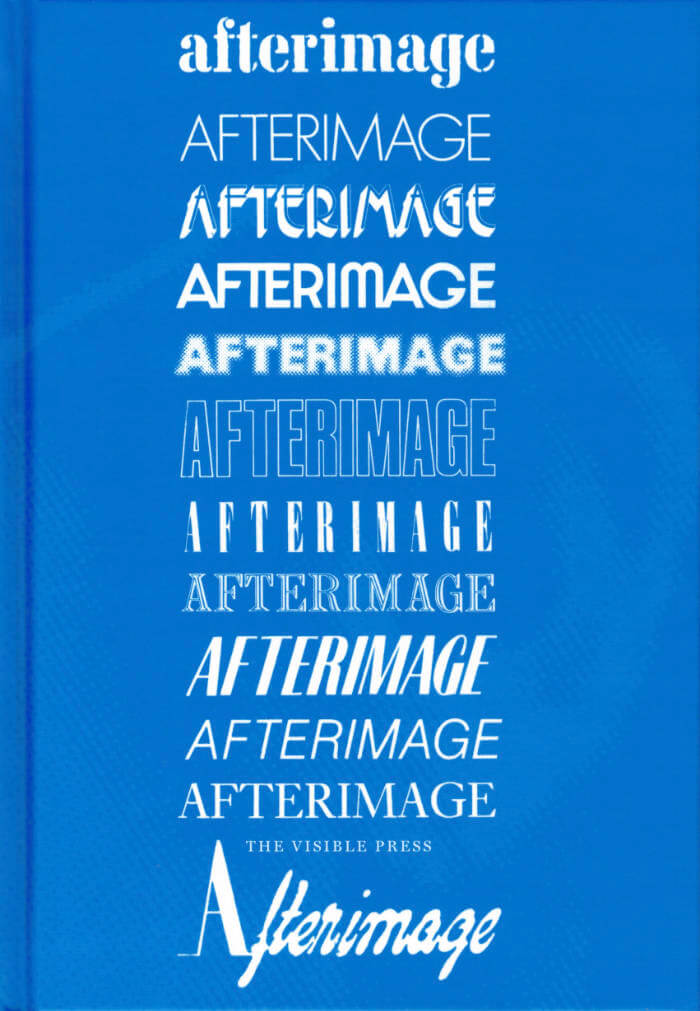
The Afterimage Reader
The independent British film journal Afterimage published thirteen issues between 1970 and 1987. International in scope, it surveyed the many forms of radical cinema during an extraordinary period of film history.
Having emerged in the wake of post-1968 cultural and political change, Afterimage charted contemporary developments with special issues on themes such as the avant-garde, Latin American cinema and visionary animation, and also looked back at early film pioneers. It published many of the leading critics of the period and vitally provided a forum for filmmakers’ writings and manifestos.
This indispensable collection includes texts by scholars Noël Burch, Roger Cardinal, B. Ruby Rich and Peter Wollen, filmmakers Jean Epstein, Jean-Luc Godard, Derek Jarman and Jan Švankmajer, plus extended interviews with Hollis Frampton and Raúl Ruiz, and more.
The Afterimage Reader is edited by Mark Webber and features new contributions from two of the journal’s editors, Simon Field and Ian Christie.
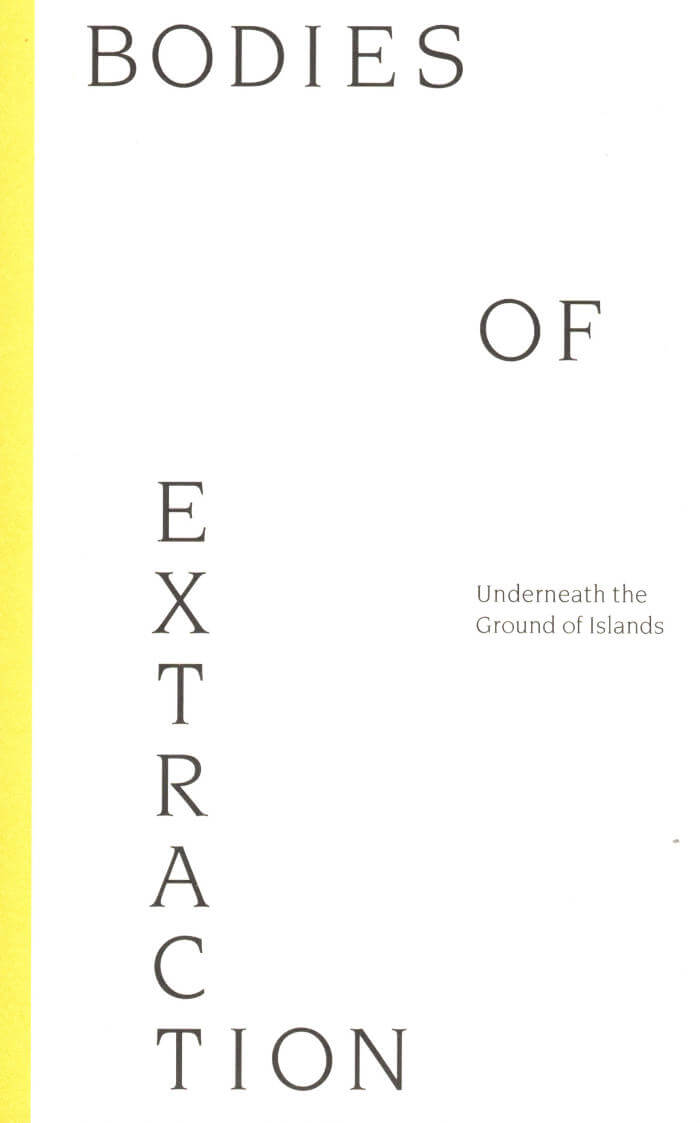
Bodies of Extraction
Lydia Xynogala, Lorena Vicini and 1 more
What does it mean to drill deep and interfere with the configuration of tectonic plates? What does it mean to hollow out and alienate islandic undergrounds? How is wealth extracted and exploited from the ground, crumbled into fragments, transformed into matter, pieces of power, moved away to be represented elsewhere? Whose lungs and souls are capitalized upon and hidden under the suffocating dust in mining shafts? To whom do the surface of the land and its underground belong?
This book takes proto-industrial mining in the Aegean island of Serifos as an entry point for disclosing historical and contemporary consequences of politics of the soil through land extraction, and looks at how mineral evidence was historically produced, disseminated, and capitalized upon in the Aegean region and beyond.
Contents:
Mineral Travels:
Fragments of Geographies on the Move
by Lydia Xynogala
The Evil in the Surface
by Lorena Vicini
Consuming Land at Serifos
by Asli Özdoyuran
and David Bergé
Letter from Frikas Fortress
by Constantinos Speras
Iron Lungs
by Milica Ivic
Walking on Marble: Materialized Histories
by Anna Run Tryggvadottir
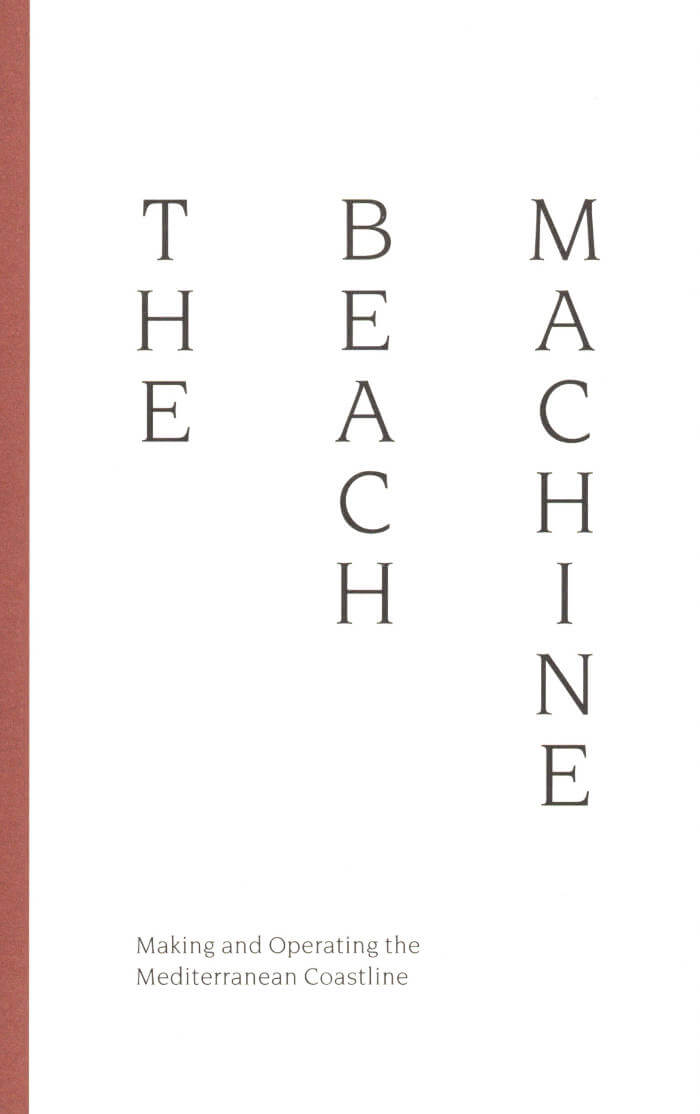
The Beach Machine
Aggressively rebounding after recessions and the pandemic, sprawling landscapes of tourism in the Mediterranean continue to build upon the iconic spatial typology of sea & sun vacationing: the beach. But behind the leisurely scattered bodies and the quiescent summer shores, beachfronts are assembled as intensely ordered infrastructures for the heavy machineries of tourism.
Approaching the beach as an operational socio-technical landscape, this book unpacks stories of construction, programming, and maintenance: from traces of moving sands in Lefkada island to mirror postwar developments in Delos and Mykonos islands, and from historic and bodily excursions to workings of the Athenian riviera to rituals of eco-certification under Blue Flags.
The texts frame the beach as a machine, one with protocols of function and metabolic needs, studying how it directs the capture of land and bodies, while establishing forms of environmental control. As a repeatable and proliferating type of infrastructure space, the beach has the potential to expose parallel evidence of seeming globalizations and patchy planetarities.
Contents:
Flying Flags, Fixing Sands
by George Papam
Moving Sands: Ammoglossa
by Eleni Grapsa
Delos Symposia
and Delos LTD:
Making Global Leisurescapes
by Petros Phokaides
Beach Making:
The Naked Body on the Rocks
by Phevos Kallitsis
Beach Effect
by Hannah Freed-Thall
Hello Hygiene:
A Guide for Bathers
by Lydia Xynogala

Kwetsbaarheid — Over raken en geraakt worden
Marlies De Munck en Pascal Gielen
In een competitief bestaan verbergen we onze zwakke plekken. Evaluatiedrift en de voortdurende dwang tot innoveren duwen mensen steeds verder weg in een bolster. Hoe danook gaan we allen als knoeiers door het leven, vindt Marlies De Munck. Ze roept daarom op tot openheid en mededogen. Want dat bolsteren hindert je om te raken. En om geraakt te worden. Pascal Gielen houdt een warm pleidooi voor een esthetische kunde: het vermogen via al onze zintuigen een rammelende en fragiele werkelijkheid toch als een samenhangend geheel te ervaren. Dat is de potentie van kunst en cultuur: om ons te verzoenen met een chaotisch en kwetsbaar leven.
Marlies De Munck is cultuurfilosofe. Ze is als docent verbonden aan het Departement Wijsbegeerte van de Universiteit Antwerpen en aan het KASK & Conservatorium in Gent. Als lid van het Culture Commons Quest Office (CCQO) aan het Antwerp Research Institute For the Arts (ARIA) doet ze onderzoek naar de gezondheid van cultuur.

Art and Solidarity Reader
Solidarity has re-entered the global zeitgeist with resounding force in the last decades and is especially urgent to consider today. Yet this concept – both a potent ideal and a slippery notion – is one of the least analysed within the arts. Why? It is perhaps because colonialism, Neoliberalism, hyper-individualism and Western-centred concepts of art have eroded visions of a care-based society. Creating a fair and vital social fabric inspired by mutual dependencies between living beings and all entities including fauna, flora, air, land and water, is fundamental for our collective existence.
A critical toolbox with intersectional perspectives is needed to examine this minefield and reveal meaningful and inspiring narratives that can guide our future.
Contributors: Reem Abbas, Toufoul Abou-Hodeib, Noor Abuarafeh, Yásnaya Elena Aguilar Gil, Ali Hussein Al-Adawy, Salvador Allende, Beth Brant, Wendy Carrig, Heather Dewey-Hagborg, Emory Douglas, Ntone Edjabe, Ingrid Fadnes, Eva Maria Fjellheim, Katya García-Antón, Soledad García Saavedra, Gavin Jantjes, Shoili Kanungo, Geeta Kapur, Lara Khaldi, Ixchel León, Audre Lorde, Chelsea Manning, Olivier Marboeuf, Barbara Masekela, Naeem Mohaiemen, Mário Pedrosa, Ram Rahman, Laura Raicovich, farid rakun/ruangrupa, Aban Raza, Devika Singh, Irene Soria Guzmán, Kwanele Sosibo, Eszter Szakács, Dulce Celina Ureña Hernández, Alice Walker.

Textes à lire à voix haute
A collection of texts by fifteen contemporary Brazilian authors who approach the notions of care and privilege from a transfeminist, anti-racist and decolonialcritical perspective.
Edited by Diane Lima, Cíntia Guedes, abigail Campos Leal.
Texts by Ricardo Aleixo, Pacha Ana, Castiel Vitorino Brasileiro, Monna Brutal, Rebeca Carapiá, Pêdra Costa, Ingrid Martins, muSa Michelle Mattiuzzi, Jota Mombaça, tatiana nascimento, Elton Panamby, Grace Passô, Miro Spinelli, Preto Téo, Lucas Veiga.
Translated from the Portuguese (Brasil) by Luana Almeida, Valentina D'Avenia, Léa Meier, aurore/a zachayus.

Or, on Being the Other Woman
Throughout this book-length poem, Simone White considers the dynamics of contemporary black feminist life, attesting to the narrative complexities of writing and living as a black woman and artist.
In Or, on being the other woman, Simone White considers the dynamics of contemporary black feminist life. Throughout this book-length poem, White writes through a hybrid of poetry, essay, personal narrative, and critical theory, attesting to the narrative complexities of writing and living as a black woman and artist. She considers black social life—from art and motherhood to trap music and love—as unspeakably troubling and reflects on the degree to which it strands and punishes black women. She also explores what constitutes sexual freedom and the rewards and dangers that come with it. White meditates on trap music and the ways artists such as Future and Meek Mill and the sonic waves of the drum machine convey desire and the black experience. Charting the pressures of ordinary black womanhood, White pushes the limits of language, showing how those limits can be the basis for new modes of expression.

Gossiping is Not (Just) Bitching
Gossiping is Not (Just) Bitching is a zine transcribing a performance revolving around the clichés attributed to gossip, addressing the oppression exerted on women and queer voices. Informal discussions, defined as futile, are discredited as marginal, practised by people who don’t always have access to public speech. The performance deconstructs different uses of gossip, exploring its political significance through the interpretation of sources from sociology, literature, chick-flicks and reality TV.
More images at
https://aurianepreudhomme.com/gossiping-is-not-just-bitching-artist-book-2022/

And Then Comes the Chorus
In the high-octane essay And Then Comes the Chorus, Jon Refsdal Moe pursues the imagination of theatre opened up by Alfred Jarry when he slipped an ‘r’ into a profanity as he exclaimed ‘Merdre!’ on stage. ‘What matters is that the words became flesh and that this flesh exploded right in the world’s face. What matters is that literature stood up at the Théâtre de l’Œuvre on December 10, 1896 and cried FUCK! and all hell broke loose and the world has never been the same since.’
Jon Refsdal Moe is a writer and dramaturg from Oslo. He has written two novels, one doctoral dissertation, several essays and a lot of criticism. He was artistic director of Black Box teater in Oslo from 2009 to 2016 and is now professor of dramaturgy at Stockholm University of the Arts.
Published by Varamo Press in the essay series Gestures
First edition November 2022
48 pages, 11.0 x 16.5 cm, sewn perfect binding
ISBN: 978-82-691492-8-9
Graphic design by Michaël Bussaer

Ulysses Jenkins: Without Your Interpretation
The first monograph on the groundbreaking video artist and member of the seminal Video Venice News and Studio Z groups.
This is the first major retrospective on the groundbreaking Los Angeles-based video artist Ulysses Jenkins (born 1946). Since the 1970s, Jenkins has interrogated questions of race and gender as they relate to ritual, history and state power. From his work with Video Venice News, a Los Angeles media collective he founded in the early 1970s, to his involvement with the artists' group Studio Z (alongside figures such as David Hammons, Senga Nengudi and Maren Hassinger), to his video and performance works, Jenkins explores how white supremacy is embedded in popular culture. Beginning as a painter and muralist, Jenkins was introduced to video just as the first consumer cameras were made available, and he quickly seized upon the technology as a means to broadcast critical depictions of multiculturalism. This catalog features an extensive portion of Jenkins' archive, early documentary films, photographs and ephemera, as well as his video art.

Carolee Schneemann: From Then and Beyond
An oral-visual autobiography of Carolee Schneeman, with portraits of her home and working life.
The pioneering artist Carolee Schneemann (1939-2019) embraced a wide range of mediums: from painting to performance, film and video to mixed media and installations, famously applying the gestural physicality of action painting to kinetic environments and performances centered on the body—more often than not, her own. Many of the artist's works have entered the canon of contemporary art, such as Eye Body (1963), Fuses (1964), Meat Joy (1964), Up To and Including Her Limits (1974) and Interior Scroll (1975).
From Then and Beyond consists of interviews with Schneemann conducted by art historian Oliver Kielmayer (Kunsthalle Winterthur) and curator Lara Pan at her home in New Paltz, New York. The transcript of these interviews, edited into 27 monologues and dialogues, is the last substantial testimony by the artist and is complemented by illustrations of her works and photographs of her house.
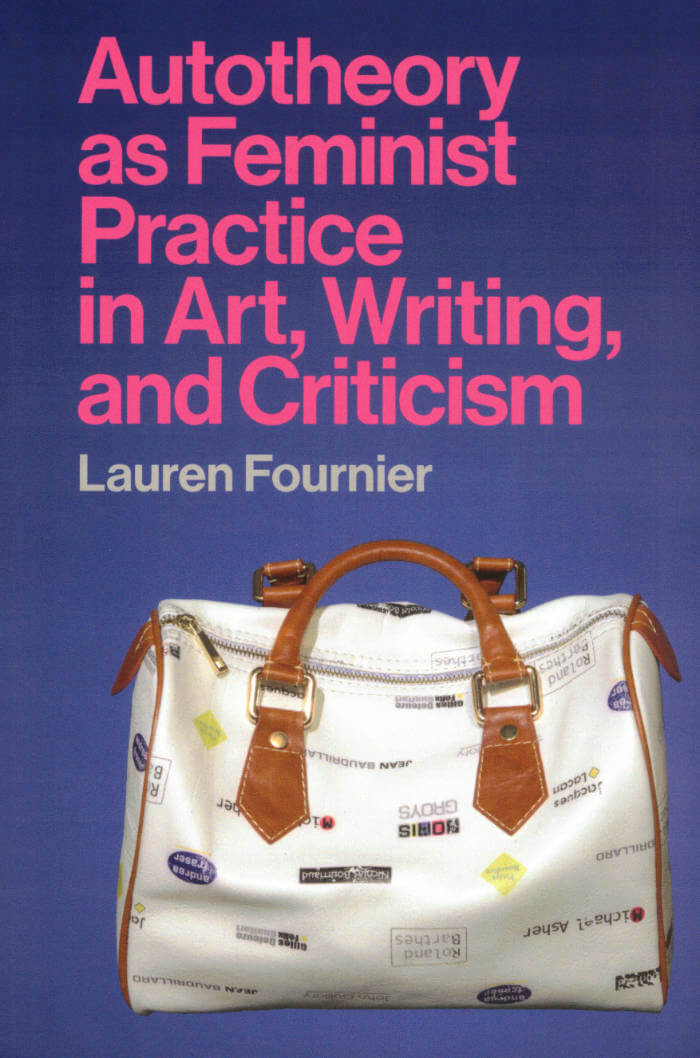
Autotheory as Feminist Practice in Art, Writing, and Criticism
Autotheory—the commingling of theory and philosophy with autobiography—as a mode of critical artistic practice indebted to feminist writing and activism.
In the 2010s, the term “autotheory” began to trend in literary spheres, where it was used to describe books in which memoir and autobiography fused with theory and philosophy. In this book, Lauren Fournier extends the meaning of the term, applying it to other disciplines and practices. Fournier provides a long-awaited account of autotheory, situating it as a mode of contemporary, post-1960s artistic practice that is indebted to feminist writing, art, and activism. Investigating a series of works by writers and artists including Chris Kraus and Adrian Piper, she considers the politics, aesthetics, and ethics of autotheory.
Fournier argues that the autotheoretical turn signals the tenuousness of illusory separations between art and life, theory and practice, work and the self—divisions long blurred by feminist artists and scholars. Autotheory challenges dominant approaches to philosophizing and theorizing while enabling new ways for artists and writers to reflect on their lives. She argues that Kraus's 1997 I Love Dick marked the emergence of a newly performative, post-memoir “I”; recasts Piper's 1971 performance work Food for the Spirit as autotheory; considers autotheory as critique; examines practices of citation in autotheoretical work, including Maggie Nelson's The Argonauts; and looks at the aesthetics and ethics of disclosure and exposure, exploring the nuanced feminist politics around autotheoretical practices and such movements as #MeToo. Fournier formulates autotheory as a reflexive movement, connecting thinking, making art, living, and theorizing.

How to Become Irrésistibles
How to become Irrésistibles est une édition de l'école supérieure des beaux-arts de Bordeaux réalisée avec la maison d'édition How to Become.
Cette édition est née de l'énergie d'un groupe d'autrices étudiantes de l'école des beaux arts de Bordeaux. Elles (car il s'agit d'une majorité de femmes) se rassemblent dans les séminaires Irrésistibles – briser les cases (art-femmes-territoires) dirigés par Marie Legros, artiste et professeure. Ce séminaire a été créé par cette dernière en 2016 afin d'encourager les pratiques féministes dans l'écriture. Qu'est-ce que c'est ? Des façons autres d'écrire le genre (l'identité) et les genres (littéraires), la langue (nationale) et de faire entrer du commun dans l'écriture (en arrêtant d'en exclure les femmes, les homos, les personnes racisées, les prolos). Les étudiantes qui participent à ce séminaire, issues de nationalités différentes, s'en sont saisis pour tordre la généalogie poétique franco-française masculiniste. L'autrice et éditrice sabrina soyer (éditions How to become), invitée à prendre part aux recherches dans ce séminaire, a coordonné cet ouvrage en l'axant sur des échanges de traduction entre autrices et l'usage du français comme langue étrangère. Le livre explore – c'est à dire donne de la valeur à – différentes formes de contacts entre auteurices : traductions, réponses adressées, écriture sous influence ou fan fiction... Chaque langue et voix se tisse en écho à une autre, pas de poèmes isolés, un grand texte comme un grand corps amassé par rebonds et frottements.
Avec : Hani Yikyung Han, Nayun Eom, Charles Dauphinot, Layan Qarain, Viktoria Oresho, Samuel R. Delany, Seobin Park, Jie Liang, Rami Karim, Yu-Wen Wang, Ching-Chuan Kuo, Mélanie Blaison, Barbara Sirieix, sabrina soyer, Yan Tong Liu, Jessica Guez Karen Johanns, Marie Legros M, Esther Sauzet, Mira Mattar.

What Makes an Assembly? – Stories, Experiments, and Inquiries
Laurent Jeanpierre, Anne Davidian
A crossdisciplinary inquiry into the practices and forms of assembly making, through multiple times and geographies.
Assemblies are ancestral, transcultural ways of coming together as a community. Over the past decades, multiple social movements have reappropriated these forms of collective organisation as a prominent component of political struggle, to defend radical visions of democracy. At the same time, governments across the globe have sought to reframe public deliberation as a response to the failures of representative democracy.
How can we analyze this double movement, and could assemblies of equals once again offer possibilities to reimagine and renew the ways politics is practiced? To address these questions, we need to move beyond simply asking what assemblies can do, and instead examine how they are made. This means departing from the shores of a speculative, deliberative ideal and restoring attention to both their diversity of forms, and their capacities to perform, deform, and transform.
Bringing together accounts written by those who practice assemblies, and contributions from artists, activists, historians, philosophers, and social scientists, as well as three architectural experiments that attempt to imagine models for a future assembly, the book proposes a critical inquiry into the potential of assemblies to shape political subjects. From assemblies in Indigenous territories of Brazil to those of the Yellow Vests in France, from medieval communes to street parliaments in Africa, from citizens' assemblies set up by public authorities to practices forged from emancipatory traditions, What Makes An Assembly? examines the tensions that exist in all assemblies between the need for form and the danger of formalization; between the scripts, rituals, and architectural settings from which they derive, and their capacity to erupt and emerge anew.
Contributions by Ayreen Anastas, Andreas Angelidakis, Hans Asenbaum, Frédérique Aït-Touati, Richard Banégas, Sandra Benites, Jean Godefroy Bidima, Patrick Boucheron, Florence Brisset-Foucault, Manuel Callahan, François Cooren, Armando Cutolo, Pascale Dufour, Ben Eersels, Tallulah Frappier, Rene Gabri, Delphine Gardey, Alana Gerecke, Andrés Jaque/Office for Political Innovation, Laurent Jeanpierre, Pablo Lafuente, Laura Levin, Stacey Liou, Catherine Malabou, Charlotte Malterre-Barthes, Florian Malzacher, Piersandra Di Matteo, Markus Miessen, raumlabor, Philippe Urfalino, Yellow Vests, Aleksandra Wasilkowska, Ana Terra Yawalapiti.

Spike #73 – Vulnerability
To live means to be exposed, to be vulnerable, and seek safety. But what if we give up control and don't try to cover the wounds any more? Could we ultimately transcend to openness? This is one of the core questions Spike asks in its autumn issue. From the imperfections of the body to automated text generators, from poor images to pop stars. Spike #73 is about art's soft underbelly, why writing in first person is a risk, why humans fear each other, and grappling with grief, paranoia, and intoxication. Let's find out what happens if we take off our shells.
With contributions by: McKenzie Wark, Marlene Dumas, Tosh Basco, James Richards, Raimundas Malašauskas, Joanna Walsh, Kandis Williams, Mire Lee, Gustav Metzger, Rob Horning, Tea Hacic-Vlahovic, Constance Debré, Luca Lo Pinto, Simone Forti...

Sint-Lucas School of Arts Antwerp
TYPP #8 — Blind Spot
The human eye is designed with a flaw that is common to all other vertebrates: we have a blind spot, the punctum caecum, a small patch on the inside of our boisterous orbs of vision with no photoreceptors. A blind spot can also be psychological or social. We tend to be biased towards situations or people we cannot fully ‘see through’. How can we enlighten our blind spots? What kind of artistic practices can inspire new readings of history, art, music, or even politics?
With contributions by Bent Vande Sompele, Pierre-Antoine Vettorello & Stella Nyanchama Okemwa, and Haseeb Ahmed. Design by Ward Heirwegh. Chief Editor: Zeynep Kubat. Editorial Board: Mekhitar Garabedian, Caroline Dumalin, Saskia Van der Gucht, Paul Hendrikse.

nY49 — trans*
Sven Van den Bossche, Hans Demeyer and 1 more
“Een thematisch nummer maken over trans*esthetiek riskeert trans*heid meteen als iets aparts te signaleren, als iets wat niet simpelweg kan zijn; hoe stel je ‘gewoon’ een special issue samen?”
Het nummer werd samengesteld door Dagmar Bosma, Hans Demeyer en Sven Van den Bossche.
Met bijdrages van: Ada M. Patterson, Camille Pier, Sven Van den Bossche, Alara Adilow, Nour Helou & Afrang Nordlöf Malekian, Mariken Heitman, misha verdonck, Dagmar Bosma, Hans Demeyer, Torrey Peters, Kato Trieu, Valentijn Hoogenkamp, Romeo Roxman Gatt, Lieks Hettinga, Kalib Batta, Kopano Maroga, Hannah Chris Lomans en Nele Buyst.
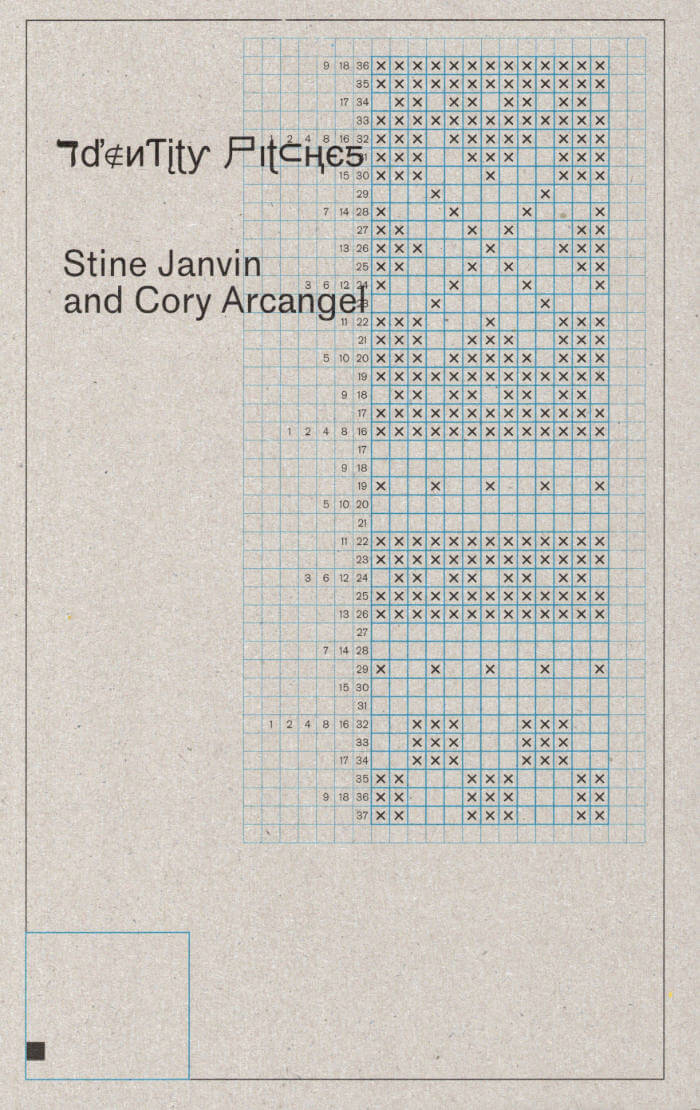
Identity Pitches
A collaborative artist's book of musical scores based on Norwegian knitting patterns.
For Identity Pitches, artists Cory Arcangel (born 1978) and Stine Janvin (born 1985) have composed conceptual music scores based on the knitting patterns for traditional Norwegian sweaters known as Lusekofte. Utilizing three of the most popular designs (Setesdal, Fana and the eight-petal rose of Selbu) of this ubiquitous garment, Janvin creates scores for both solo and ensemble performers by mapping the knitting patterns onto the harmonic and subharmonic series and integrating the tuning principles of traditional Norwegian instruments. These scores are further manipulated by Arcangel using a custom "deep-fried" coding script to create a series of image glitches.
A foreword and an interview between the two artists, both based in Stavanger, Norway, provide context for the work, delving into the history of Norwegian folk music tunings and the Lusekofte sweater and their intersection with the cultural identity of the country over the last millennium.

ABÉCÉDAIRE
“I wrote (more or less, for promises are always hard to keep, even those made to oneself ) for five days a week for a year. I wrote no more than a page, or rather, I wrote only for the length of the analytic hour, fifty minutes (though I also practiced the variable session at times)… I followed Freud’s model of train travel for his theory of free association, acting ‘as though, for instance, [you were] a traveller sitting next to the window of a railway carriage and describing to someone inside the carriage the changing views which [you] see outside’. As for my characters, many of their names begin with A. Some of these women exist or existed, others are from fiction, or write fiction. Some are friends or acquaintances. None are credited but a keen reader could recognise many of them. I invented nothing. I am the aleph.”

Robida magazine n. 8 — Isola Otok Island
Robida 8 is imagined and organised as a journey, that can explore aspects of island life along a narrative thread, as if developing the structure of an epic voyage: from the Embarkation – where introductory perspectives on islands are offered –, then into the Departure – which considers the islands from afar, as conceptual entities –, through the Tempest – representative of the turmoils and movement that island stand for –, passing from the Strandedness – where the island coincides with stillness –, to finally approach the Homecoming, and the island as repository of collective as well as personal memory. The aim is for this journey to enrich our understanding of islands, as fertile ground for exploring what it means to inhabit a place.
Robida is a multilingual cultural magazine. It is published yearly by the association Robida which is based in Topolò, a village of twenty inhabitants on the border between Italy and Slovenia. The magazine explores different topics – such as abandonment, silence, the relation between domesticity and wildness, forest etc. – which are connected to the place where the magazine comes to life, namely Topolò. The eight issue reflects on the island which is explored through essays, photography, art projects, academic texts, interviews and personal written by authors from all over the world, from Argentina to Poland, from US to Slovenia.
Trilingual edition: Italian / Slovenian / English
Editorial board: Dora Ciccone, Maria Moschioni, Elena Rucli, Vida Rucli, Laura Savina, Aljaž Škrlep, Janja Šušnjar.
Contributors: Adele Dipasquale and Cristina Lavosi, Adriana Gallo, Agnieszka Dragon, Ajda Bračič, Alessandro Simone and Francesca Cassi, Alice Pedroletti and Alessandra Saviotti, Ana Escariz Péres, Anna Bierler, Anne Kathrin Müller, Antônio Frederico Lasalvia, Brechje Krah, Camilla Isola, Camilla Marrese and Gabriele Chiapparini, Chiara Alexandra Young, Chiara Dorbolò, Constanze Flamme, Deborah Mora, Dora Ciccone, Elena Rucli, Federica Carlotta Lai, Gabriele Zagaglia and Fernanda Villari, Giacomo Bianco, Giampaolo De Pietro, Giuditta Trani, Greta Biondi and Vittoria Rubini, Guglielmo Giomi, Haydée Touitou, Igor Martinig, Kaja Rakušček, Katrina Pelikan Bašelj, Laura Savina, Léna Lewis-King, Livia Galtieri, Ludivine Gragy, Ludovica Battista, make LARMO, Mara-Luna Brandt Corstius, Marcos Beccari, Margherita Falqui, Marie Ilse Bourlanges, Marie Kerkeling, Marta Marini and Cecilia Bima, Marta Marini and Francesca Matracchi, Mauro Tosarelli, Melissa Carnemolla, Mercedes Villalba, Ola Korbańska, Olya Korsun, Opher Thomson, Rachele Daminelli, Romane Bourgeois, Silvia Sfiligiotti, Siria Falleroni, Stefano Conti, Tanja Marmai, Titta C. Raccagni, Tymon Hogenelst and Jesse van der Ploeg, Valerija Intihar, Vidya Narine, William Belloche.